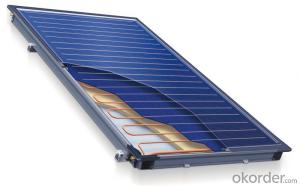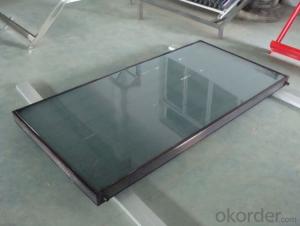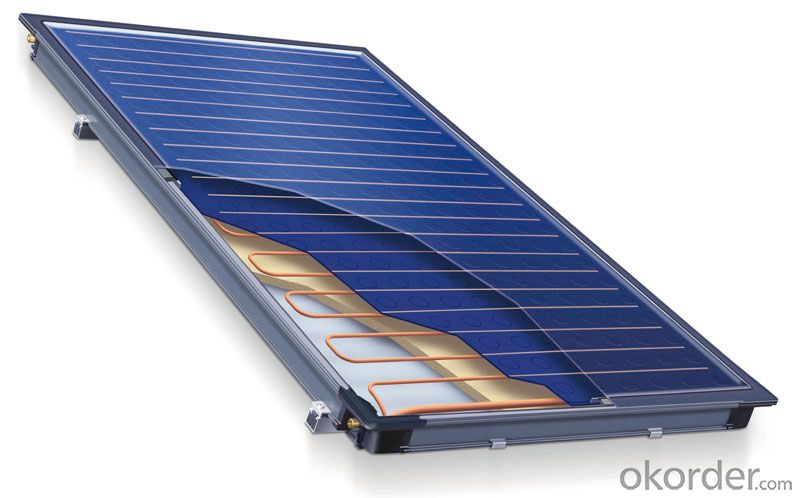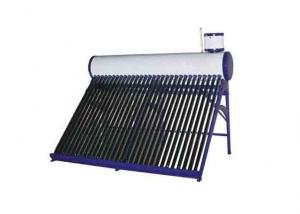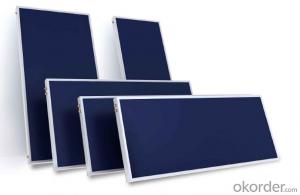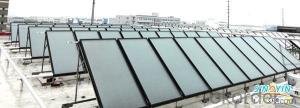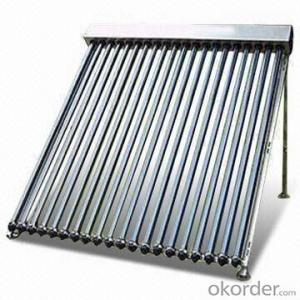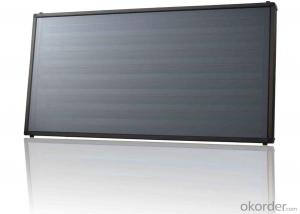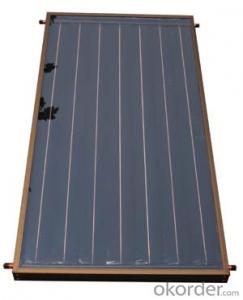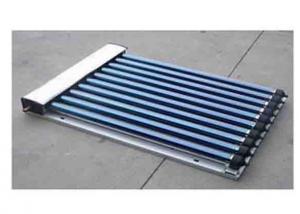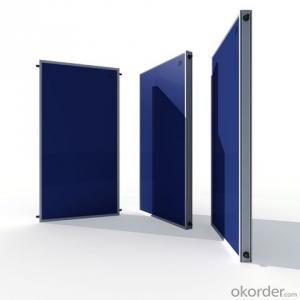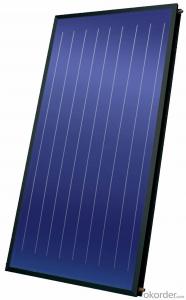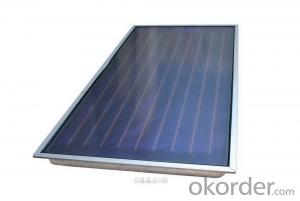seperated flat plate solar collector solar thermal collector
- Loading Port:
- Shanghai
- Payment Terms:
- TT OR LC
- Min Order Qty:
- 500 pc
- Supply Capability:
- 10000 pc/month
OKorder Service Pledge
OKorder Financial Service
You Might Also Like
Specifications
Sunshore non pressure solar collector
CE, Solar keymark certificate
Low pressure, high efficiency. low cost
Commercial use
Sunshore vacuum tube non pressure solar collector
Detail of material:
Outer tank: Al-Zn coated steel sheet
Inner tank: SUS 304-2B stainless steel sheet
Insulation: Polyurethane foam
Vacuum tube: Borosilicate glass 3.3
Absorption coating: Al-N-Cu-SS
Stand: Aluminum Alloy/Galvanized sheet
Feature of Flat Plate collector:
1.using patent advanced coating technology with high efficiency performance
2.High strength aluminium-alloy structure with surface varnish baking
3.High visual shape, easy installation, maintenance free
4.Pressurized designing, operate with pressure up to 1 MPa
5.Can be combined with existing energy
Features:
Copper pipes and fins
Blue Vacuum Coating
American ultrasonic welding
Tempered glass cover
Size: 2000*1000*90mm
Advantages:
Great pressurization property, very safe and clean.
Absorption ≥95%; emission ≤5%.
Strong thermal stability.
Strong welding property and conductivity.
Strong protection to the collector.
Benefits:
Durable and corrosion-resistant material makes your maintenance cost low.
Comfortable hot water can be gained even in medium solar radiation areas.
Increases the value of your property.
Long lifespan to 25 years, makes your investment more worth it.
Worry-free from hails or other terrible weathers.
Product advantage
Solar energy (Solar) generally refers to the Sun's radiant energy which is used as the modern general power generation. The water tank adopts stainless steel SUS304 food grade material, Corrosion resistance and durable .The brackets Using aluminum alloy material,USES the word "people" streamlined support, and combine the water tank, strong and durable .The vacuum tube is made of high quality high borosilicate, hard glass production,Good light transmittance,Heat faster Heat preservation is better. Our company can produces its own water tank bracket and vacuum tubes,Its products over the years committed to technology innovation,So the quality and service guaranteed and there are quite a preferential price.So many advantages is your best choose!
How it works
The design of this type uses the all-glass evacuated solar collector tubes as the heat absorb element. The high vacuum degree of the clearance between the outer and inner tube can reduce the heat emission which caused by convection and conduction to a very low level. All-glass evacuated tube transfers sun energy into heat energy by high absorption rate and low emittance rate of layer films. Depend on the different density between the hot water and the cold water, a cycle created in the tube which hot water ascending and cold water descending status. Keeping natural circulation like this, the water in the tank will be heated. Flat plate collectors are an extension of the basic idea to place a collector in an 'oven'-like box. Here, a pipe is connected to the water tank and the water is circulated through this pipe and back into the tank. The water tank is now outside the collector that only contains the pipes. Since the surface-to-volume ratio increases sharply as the diameter of a pipe decreases, most flat-plate collectors have pipes less than 1 cm in diameter. The efficiency of the heating process is therefore sharply increased. The design of a flat-plate collector therefore typically takes the shape of a flat box with a robust glass top oriented towards the sun, enclosing a network of piping. In many flat-plate collectors the metal surface of the pipe is increased with flat metal flanges or even a large, flat metal plate to which the pipes are connected. Since the water in a flat-plate collector usually reaches temperatures much higher than that of an ICS, the problem of radiation of heat back to the environment is very important, even though a box-like 'oven' is used.
- Q:Are solar collectors suitable for heating schools and universities?
- Yes, solar collectors are suitable for heating schools and universities. They are highly efficient in capturing sunlight and converting it into usable heat energy. Solar heating systems can be installed on rooftops or in open spaces, providing a cost-effective and sustainable solution for heating large educational institutions. Additionally, using solar energy reduces reliance on fossil fuels, helping to reduce carbon emissions and promote environmental sustainability.
- Q:Can solar collectors be used for heating warehouses and distribution centers?
- Yes, solar collectors can be used for heating warehouses and distribution centers. Solar thermal collectors can capture the sun's energy and convert it into heat, which can then be used to warm up the interior spaces of warehouses and distribution centers. This renewable energy source can help reduce reliance on traditional heating methods and lower energy costs, making it an environmentally friendly and cost-effective solution for heating large commercial spaces.
- Q:Can solar collectors be used for heating sports arenas?
- Yes, solar collectors can be used for heating sports arenas. Solar collectors, also known as solar thermal systems, can efficiently convert sunlight into heat energy, which can be used for various applications, including heating large spaces like sports arenas. Solar collectors consist of solar panels that absorb sunlight and convert it into thermal energy. This thermal energy can then be transferred to a heating system, such as a radiant floor heating system or a forced air system, to provide warmth to the arena. To effectively heat a sports arena, a considerable number of solar collectors may be required, depending on the size of the arena and the desired temperature. The collectors can be installed on the roof of the arena or in nearby open spaces where they can receive maximum sunlight exposure. Using solar collectors for heating sports arenas offers several advantages. Firstly, it is a sustainable and renewable energy source, reducing reliance on fossil fuels and lowering greenhouse gas emissions. This helps to mitigate climate change and promote environmental sustainability. Secondly, solar heating systems can significantly reduce energy costs for sports arenas. While the initial installation cost may be higher compared to traditional heating systems, the long-term operational costs are typically lower due to the free and abundant energy provided by the sun. Finally, solar collectors can provide consistent heating throughout the year, even on cloudy days, as they can still absorb and convert solar energy, albeit at a slightly reduced efficiency. Additionally, excess thermal energy can be stored in thermal banks or used for other purposes, ensuring a continuous heat supply for the arena. In conclusion, solar collectors can indeed be used for heating sports arenas. Their ability to convert sunlight into thermal energy, coupled with their environmental and economic advantages, make them a viable and sustainable heating solution for large spaces like sports arenas.
- Q:How do solar collectors impact the environment?
- Solar collectors have a positive impact on the environment as they harness renewable solar energy, reducing the dependency on fossil fuels. They help in mitigating greenhouse gas emissions, air pollution, and climate change while conserving natural resources. Additionally, solar collectors do not produce any harmful byproducts or waste, making them an environmentally-friendly energy solution.
- Q:Are there any limitations on the size of a solar collector system?
- Yes, there are limitations on the size of a solar collector system. The size of the system is typically limited by available space, budget constraints, and the power needs of the building or facility it is intended to serve. Additionally, local regulations and building codes may impose restrictions on the maximum size of the solar collector system.
- Q:Can solar collectors be used for heating beverage production facilities?
- Yes, solar collectors can be used for heating beverage production facilities. Solar thermal systems, such as flat plate or evacuated tube collectors, can capture the sun's energy and convert it into heat, which can then be used for water heating or space heating in the facility. This can help reduce the reliance on traditional heating methods and decrease energy costs while promoting sustainability.
- Q:How do solar collectors compare to traditional heating systems in terms of efficiency?
- Solar collectors are generally more efficient than traditional heating systems because they utilize renewable energy from the sun to generate heat. Traditional heating systems, on the other hand, rely on fossil fuels or electricity, which can be less efficient and have a higher environmental impact.
- Q:Are solar collectors suitable for off-grid living?
- Yes, solar collectors are highly suitable for off-grid living. They provide a reliable and sustainable source of energy, allowing individuals to generate electricity and heat water without being connected to the traditional power grid. Solar collectors are particularly beneficial in remote areas where access to electricity may be limited or expensive. They offer a cost-effective and environmentally friendly solution for off-grid living, reducing dependence on fossil fuels and minimizing carbon emissions.
- Q:What are the different types of solar collectors?
- There are three main types of solar collectors: flat-plate collectors, evacuated tube collectors, and parabolic trough collectors.
- Q:Are there any disadvantages to using solar collectors?
- Yes, there are a few disadvantages to using solar collectors. Firstly, the initial cost of installing solar collectors can be quite high, making it less affordable for some individuals or businesses. Additionally, solar collectors require a significant amount of space for installation, which may limit their use in densely populated areas. Furthermore, solar collectors are dependent on sunlight, so their efficiency can be affected by variations in weather conditions or seasonal changes. Lastly, the manufacturing process of solar collectors can have environmental impacts, particularly if not properly recycled or disposed of at the end of their lifespan.
1. Manufacturer Overview |
|
|---|---|
| Location | |
| Year Established | |
| Annual Output Value | |
| Main Markets | |
| Company Certifications | |
2. Manufacturer Certificates |
|
|---|---|
| a) Certification Name | |
| Range | |
| Reference | |
| Validity Period | |
3. Manufacturer Capability |
|
|---|---|
| a)Trade Capacity | |
| Nearest Port | |
| Export Percentage | |
| No.of Employees in Trade Department | |
| Language Spoken: | |
| b)Factory Information | |
| Factory Size: | |
| No. of Production Lines | |
| Contract Manufacturing | |
| Product Price Range | |
Send your message to us
seperated flat plate solar collector solar thermal collector
- Loading Port:
- Shanghai
- Payment Terms:
- TT OR LC
- Min Order Qty:
- 500 pc
- Supply Capability:
- 10000 pc/month
OKorder Service Pledge
OKorder Financial Service
Similar products
New products
Hot products
Hot Searches
Related keywords
